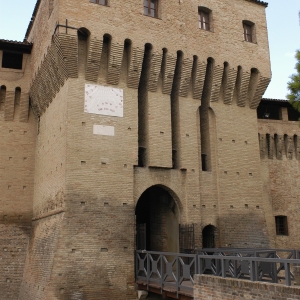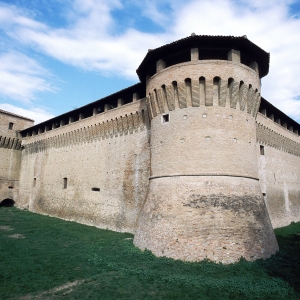The construction of a first fortress dates back to the mid-14th century: the structure was built between 1361 and 1363 at the behest of the Cardinal Legate Egidio Carrilla de Albornoz on the ruins of the Romanesque cathedral dedicated to Santa Maria Popiliense and the bishopric; it is referred to in some documents of the time as Salvaterra, to evoke the simple function it performed to guard the territory and protect the small community that had survived the destruction of the city perpetrated by the papal troops in 1360. In 1379 Sinibaldo Ordelaffi, who had become lord of Forlimpopoli by concession of Pope Urban VI,
read more
carried out the first transformation of the fortress into a real fortress. Between 1471 and 1480 Pino III Ordelaffi started an intervention that gave the structure its current size and appearance, an intervention that was completed under the rule of Gerolamo Riario and Caterina Sforza. The new fortification is characterised by mighty bastions reinforced by scarp walls, by four square-section corner towers (later, with the evolution of techniques and combat weapons, these were enclosed within circular-section walls) and, lastly, by a large moat that runs along the four sides of the fortress (of which only the eastern and southern sections are preserved today). Subsequently, the fortress passed under the rule of Cesare Borgia, the Rangoni and, between 1535 and 1578, the Zampeschi. Under the rule of the Zampeschi - first with Antonello, then with Brunoro II - the complex experienced its moment of greatest splendour; having lost its military-defensive function, it was transformed into the seat of a 'princely' court. Granted in emphyteusis, at the beginning of the 17th century, to Cardinal Aloisio Capponi, of a noble Florentine family and at the time Archbishop of Ravenna, the fortress began a slow, inexorable decline. With the arrival of the French in Romagna in 1797, the building was requisitioned and given to the new Municipality, which moved the seat of the Municipality here. In the meantime, starting from the second half of the 18th century, the complex underwent significant changes: following the demolition of the city walls, some sections of the moat (north and west sides) were filled in; four arches were opened on the western façade of the fortress, connecting the inner courtyard with the new city square that would be named after Giuseppe Garibaldi in 1885; and the donjon, now unsafe, was demolished, of which only a few ancient representations of the city remain to this day. In recent times, a major restoration project, which began in 1970 and was completed in 1990, has returned the complex to its former decorum. Currently, the northern wing houses the municipal offices; in the eastern wing, on the first floor, is the large double-volume hall reserved for the sessions of the Municipal Council: the oldest stone coat of arms of the town of Forlimpopoli, dating back to the mid-17th century, is preserved here. Along the eastern wall is the small palatine chapel, built in the 16th century, dedicated to the Eucharist; frescoes from the early 17th century are still visible, depicting: The Bread of Angels on the vault, The Fall of Manna on the right wall and The Prophet Elijah on the left wall; in this last depiction the intervention of the painter from Ravenna Francesco Longhi (1544-1618) has been recognised. The same room also houses the large historiated canvas of the Municipal Theatre, created by the Forlimpopoli painter Paolo Bacchetti (1848-1886) and depicting the destruction of Forlimpopoli and the entry of the Cardinal Legate Egidio Carrilla de Albornoz into the city. The southern wing of the Rocca houses the small but charming Municipal Theatre, today named after Giuseppe Verdi. Already established in 1821 inside the Rocca's hall of honour, it was enlarged and modernised to a design by Bertinoro architect Giacomo Fabbri between 1878 and 1882. The use of 'modern' iron reinforcements to build the floors and slender cast-iron columns to support the two rows of galleries, responded, at the time, to the dual need to obtain 'a very solid construction' from a structural point of view and, at the same time, 'maximum lightness' and airiness from an aesthetic point of view; this means that even today the small theatre in Forlimpopoli is unique in the vast panorama of structures related to entertainment, which were built in Romagna during the 19th century. Inside the hall, a plaque, the text of which was written by the poet Olindo Guerrini, commemorates the famous raid of the Passatore band on the night of 25 January 1851.
shorten







